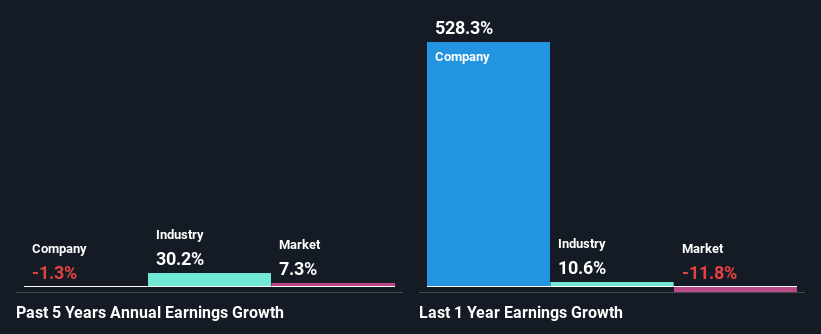Is Channel Infrastructure NZ Limited's (NZSE:CHI) Recent Performance Underpinned By Weak Financials?
Channel Infrastructure NZ (NZSE:CHI) has had a rough three months with its share price down 5.2%. To decide if this trend could continue, we decided to look at its weak fundamentals as they shape the long-term market trends. Specifically, we decided to study Channel Infrastructure NZ's ROE in this article.
ROE or return on equity is a useful tool to assess how effectively a company can generate returns on the investment it received from its shareholders. Simply put, it is used to assess the profitability of a company in relation to its equity capital.
See our latest analysis for Channel Infrastructure NZ
How Is ROE Calculated?
The formula for ROE is:
Return on Equity = Net Profit (from continuing operations) ÷ Shareholders' Equity
So, based on the above formula, the ROE for Channel Infrastructure NZ is:
5.0% = NZ$25m ÷ NZ$504m (Based on the trailing twelve months to June 2023).
The 'return' is the income the business earned over the last year. Another way to think of that is that for every NZ$1 worth of equity, the company was able to earn NZ$0.05 in profit.
What Has ROE Got To Do With Earnings Growth?
Thus far, we have learned that ROE measures how efficiently a company is generating its profits. Depending on how much of these profits the company reinvests or "retains", and how effectively it does so, we are then able to assess a company’s earnings growth potential. Assuming all else is equal, companies that have both a higher return on equity and higher profit retention are usually the ones that have a higher growth rate when compared to companies that don't have the same features.
Channel Infrastructure NZ's Earnings Growth And 5.0% ROE
On the face of it, Channel Infrastructure NZ's ROE is not much to talk about. Next, when compared to the average industry ROE of 18%, the company's ROE leaves us feeling even less enthusiastic. Therefore, Channel Infrastructure NZ's flat earnings over the past five years can possibly be explained by the low ROE amongst other factors.
Next, on comparing with the industry net income growth, we found that the industry grew its earnings by 30% over the last few years.

Earnings growth is an important metric to consider when valuing a stock. The investor should try to establish if the expected growth or decline in earnings, whichever the case may be, is priced in. This then helps them determine if the stock is placed for a bright or bleak future. Has the market priced in the future outlook for CHI? You can find out in our latest intrinsic value infographic research report.
Is Channel Infrastructure NZ Using Its Retained Earnings Effectively?
Channel Infrastructure NZ's very high three-year median payout ratio of 112% suggests that the company is paying its shareholders more than what it is earning. This does go some way in explaining the negligible earnings growth seen by Channel Infrastructure NZ. Paying a dividend higher than reported profits is not a sustainable move. This is indicative of risk. You can see the 2 risks we have identified for Channel Infrastructure NZ by visiting our risks dashboard for free on our platform here.
In addition, Channel Infrastructure NZ has been paying dividends over a period of at least ten years suggesting that keeping up dividend payments is way more important to the management even if it comes at the cost of business growth. Our latest analyst data shows that the future payout ratio of the company is expected to rise to 151% over the next three years. Regardless, the future ROE for Channel Infrastructure NZ is speculated to rise to 8.0% despite the anticipated increase in the payout ratio. There could probably be other factors that could be driving the future growth in the ROE.
Summary
Overall, we would be extremely cautious before making any decision on Channel Infrastructure NZ. Particularly, its ROE is a huge disappointment, not to mention its lack of proper reinvestment into the business. As a result its earnings growth has also been quite disappointing. With that said, we studied the latest analyst forecasts and found that while the company has shrunk its earnings in the past, analysts expect its earnings to grow in the future. Are these analysts expectations based on the broad expectations for the industry, or on the company's fundamentals? Click here to be taken to our analyst's forecasts page for the company.
Have feedback on this article? Concerned about the content? Get in touch with us directly. Alternatively, email editorial-team (at) simplywallst.com.
This article by Simply Wall St is general in nature. We provide commentary based on historical data and analyst forecasts only using an unbiased methodology and our articles are not intended to be financial advice. It does not constitute a recommendation to buy or sell any stock, and does not take account of your objectives, or your financial situation. We aim to bring you long-term focused analysis driven by fundamental data. Note that our analysis may not factor in the latest price-sensitive company announcements or qualitative material. Simply Wall St has no position in any stocks mentioned.

 Yahoo Finance
Yahoo Finance 